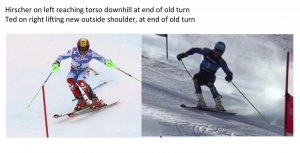....I don't think he is coaching an active move of the body into the turn, rather he is coaching a release fo the body from it's arc before the feet are released. So, you aren't so much "sending" the body somewhere as much as releasing the body to travel into the new turn. ....
....
Further, since you are effectively falling into the new turn, there's a great deal of accuracy that has to be developed for the feet to be placed at a point where they will provide an effective platform to balance against.....
Mike, I haven't subscribed to Tom Gellie's website. I have to rely on you and Geepers and whoever else is conveying that information here to explain what Tom's saying.
That said, I topple by bringing my feet back up under me so that my CoM ends up, by default, on the downhill side of my feet. IOW the CoM is released because of movement of the feet. As in Bob's video, by the way.
The first time I did this WHOAH that was a surprising sensation. Just exactly like when the roller coaster gets to the top of the first rise and travels over it. Hold onto your socks!
You say "
So for the feet to get outside of the body, they have to travel further in the arc so that they are, in effect,
uphill of the body. Sounds like the feet are still very much a part of the game."
Yes, Tom may be saying what I'm saying. I've crossed out some words so what you say he's saying is what I'm saying. Hubris, maybe. But I'm thinking I've got this right since it's something I know from experience.
Just bring your feet back up under you, in a sideways figure eight, after the fall line. Keep the skis edged as you do this. Your edges will flatten as the skis come up under you, and they will continue onto their new edges, and your body will topple as a result without you having to do anything consciously with the torso. You won't have to do a Hirscher- or Ted-style torso lunge at the top of the turn. So not either of these:

It's all in where the feet are relative to the upper body. Learning to do this with the feet means you won't know when it will happen (that accuracy thing), so be ready for the surprise. Practice will teach you when the Wheee!!! factor will kick in.
Here's a graphic from Bob's infinity video. It shows this action. The first frame shows the feet out at the fall line. In the second frame the skier is bringing them back up under the body. When the feet get to the fourth position relative to the CoM, the topple begins in earnest. You'll be technically upside down by the fifth frame, with the CoM downhill of the feet.
And no,
@Jilly, I don't teach this to my intermediate students. They have enough problems without adding a roller coaster drop to their skiing.

